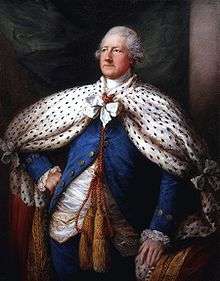John Hobart, 2nd Earl of Buckinghamshire
| The Right Honourable The Earl of Buckinghamshire PC | |
|---|---|
 | |
| Lord Lieutenant of Ireland | |
|
In office 7 December 1776 – 19 November 1780 | |
| Preceded by | The Earl Harcourt |
| Succeeded by | The Earl of Carlisle |
John Hobart, 2nd Earl of Buckinghamshire (17 August 1723 – 3 August 1793) was an English nobleman and politician.
Biography
The son of John Hobart, 1st Earl of Buckinghamshire by his first wife Judith Britiffe, he was educated at Westminster School and Christ's College, Cambridge.[1] He was Member of Parliament for Norwich from 1747–56, having also been elected for St Ives in 1747 but opting to sit for Norwich. He held office as Comptroller of the Household in 1755-56 and as a Lord of the Bedchamber from 1756–67, having succeeded his father as Earl in 1756.[2] He was Ambassador from the United Kingdom to Russia from 1762-5 and Lord Lieutenant of Ireland from 1776–80, when his Chief Secretary was Sir Richard Heron, Bt. In the latter role he had to concede free trade and, more importantly, the enactment of the Papists Act 1778 which partially repealed the Penal laws and provided measures for the relief of Roman Catholics and Dissenters.
Family
He married firstly Mary Anne Drury, daughter of Sir Thomas Drury, 1st Baronet, and secondly Caroline, daughter of William James Conolly, but died without surviving male issue and was succeeded by his half-brother.
He had three daughters by his first wife :
- Lady Harriet, Marchioness of Lothian, who married William Kerr, 6th Marquess of Lothian was the mother of John Kerr, 7th Marquess of Lothian
- Lady Caroline, who married William Assheton Harbord, 2nd Baron Suffield
- Lady Sophia, who married Richard Edgcumbe, 2nd Earl of Mount Edgcumbe
and one daughter by his second wife:
- Amelia Stewart, Viscountess Castlereagh, wife of the Foreign Secretary Robert Stewart, Viscount Castlereagh.
He was laid to rest in the family mausoleum at Blickling Hall, the family seat in Norfolk. The bodies of his two wives are also in the mausoleum, which is an unusual grade II* listed pyramidal structure designed by architect Joseph Bonomi the Elder, based on the Roman tomb of Cestius Gallus.[3]
References
- ↑ "Hobart, John (HBRT739J)". A Cambridge Alumni Database. University of Cambridge.
- ↑ James Kelly, ‘Hobart, John, second earl of Buckinghamshire (1723–1793)’, Oxford Dictionary of National Biography, Oxford University Press, 2004; online edn, Jan 2008 accessed 19 Feb 2014.
- ↑ "Name: THE MAUSOLEUM List entry Number: 1051437". English Heritage. Retrieved 12 March 2014.
- Concise Dictionary of National Biography
| Parliament of the United Kingdom | ||
|---|---|---|
| Preceded by Thomas Vere Horatio Walpole |
Member of Parliament for Norwich 1747–1756 With: Horatio Walpole 1747-1756 Edward Bacon 1756 |
Succeeded by Harbord Harbord |
| Political offices | ||
| Preceded by Earl of Hillsborough |
Comptroller of the Household 1756 |
Succeeded by Lord Edgcumbe |
| Preceded by Earl Harcourt |
Lord Lieutenant of Ireland 1776-80 |
Succeeded by Earl of Carlisle |
| Court offices | ||
| Preceded by New government |
Lord of the Bedchamber 1760–1767 |
Succeeded by The Duke of Roxburghe |
| Diplomatic posts | ||
| Preceded by Robert Murray Keith |
Ambassador from the United Kingdom to Russia 1762–1764 |
Succeeded by Earl Macartney |
| Peerage of Great Britain | ||
| Preceded by John Hobart |
Earl of Buckinghamshire 1756–1793 |
Succeeded by George Hobart |
